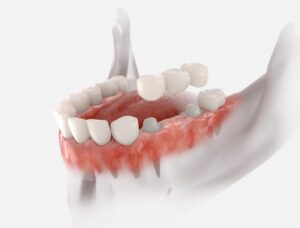
If you’re missing one or more teeth, you’re probably eager to restore your smile and chewing ability as soon as possible. Fortunately, modern dentistry offers several excellent options to replace missing teeth, including dental bridges and partial dentures. Both solutions can help fill the gaps in your smile, but the right choice depends on your specific dental needs, budget, and long-term goals. Let’s take a closer look at the differences between the two and how to determine which one might be best for you.
What is a Dental Bridge?
A dental bridge, also known as a fixed bridge, is a restoration designed to replace one or more missing teeth in a row. It’s supported either by natural teeth (which are crowned to hold the bridge in place) or by dental implants. The bridge consists of artificial teeth—called pontics—that fill the space left by your missing teeth, creating a seamless, natural-looking smile.
One of the biggest advantages of a dental bridge is that it’s permanent. Once cemented or attached to implants, it stays securely in place, allowing you to speak and eat comfortably without worrying about movement. Because it’s fixed, a bridge can feel and function much like your natural teeth.
However, a bridge is typically best suited for patients who are missing only a few teeth in a single area. If you have several gaps or missing teeth scattered across your mouth, a bridge may not be practical.
What is a Partial Denture?
A partial denture is a removable appliance that replaces multiple missing teeth in different areas of your mouth. It’s custom-made to fit snugly around your remaining natural teeth, often using a combination of metal clasps or precision attachments to hold it in place.
Partial dentures are an affordable and versatile solution that can restore your smile, improve chewing, and support your facial structure. Because they can replace teeth on both sides of your mouth, they’re ideal for patients who have lost several teeth but still have healthy remaining ones.
One of the biggest benefits of partial dentures is that they’re non-invasive—no surgery or alteration of existing teeth is required. However, since they are removable, they may take a little time to get used to and may not feel as stable as a fixed bridge.
How to Decide Which is Right for You
Choosing between a denture bridge and a partial denture depends on several factors:
- Number and location of missing teeth: A bridge works best for one or two missing teeth in the same area, while a partial denture suits multiple gaps.
- Condition of your remaining teeth: A bridge requires strong, healthy supporting teeth or implants.
- Budget and preference: Bridges are more expensive but permanent, while partial dentures are more affordable and removable.
- Long-term goals: If you want a fixed, natural-feeling option, a bridge may be ideal. If you prefer flexibility or have several missing teeth, a partial may be better.
Both dental bridges and partial dentures can beautifully restore your smile and confidence. The best way to determine which option is right for you is to schedule a consultation with your dentist. They’ll evaluate your oral health, discuss your preferences, and help design a tooth replacement plan that fits your lifestyle and goals so you can smile, eat, and speak with ease once again.
About the Author
Dr. Phillip Sehnert has been practicing dentistry for nearly 40 years, with three decades spent serving the Lewisville community. He graduated in the top 10 percent of his class at the Baylor College of Dentistry in Dallas before completing a general practice residency at Ehrling Bergquist Regional Medical Center at Offutt Air Force Base in Omaha, Nebraska, during which he received advanced training in many specialty areas of dentistry. Today, Dr. Sehnert stays current in his field through memberships in the American Dental Association, the Texas Dental Association, and Spear Education. Looking to restore your smile by replacing missing teeth? We can help! Schedule an appointment online or call (972) 420-0042.
